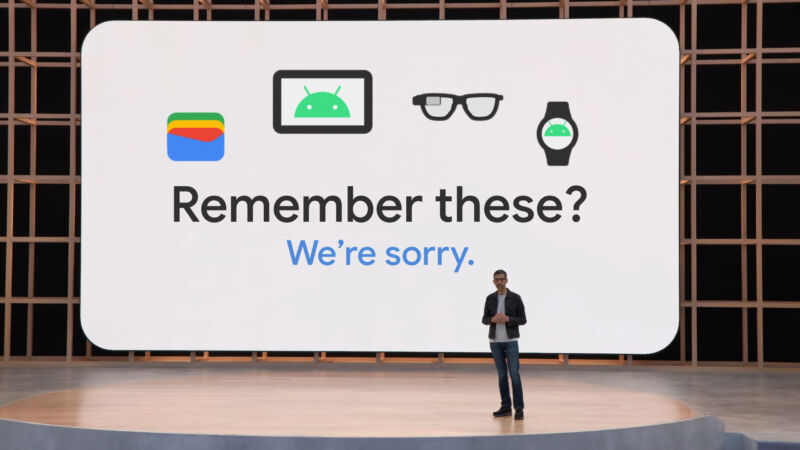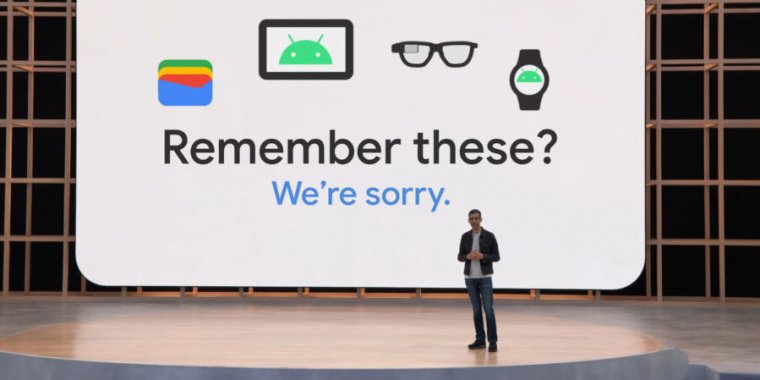
Google / Ron Amadeo
Google held its I/O conference earlier this month, and for longtime Google watchers, the event felt like a seance. Google CEO Sundar Pichai stepped on stage for his keynote address and channeled the spirits of long-dead Google products. “I’m hearing… something about an Android tablet? And a smartwatch?” he seemed to say.
By my count, “resurrecting the past” accounted for around half of the company’s major announcements. In all of these cases, Google would be in a much stronger position if it had committed to a long-term plan and continuously iterated on that plan.
Unfortunately, the company doesn’t have that kind of top-down direction. Instead, for most of the resurrected products, Google is trying to catch up to competitors after years of standing still. There’s a question we have to ask for every announcement: “Will things be different this time?”
Android tablets are back
How long have Android tablets been dead? Some companies, like Samsung, have never given up on the idea, but Google’s last piece of actual tablet hardware was the Pixel C in 2015. Android’s tablet UI has been gone for a while. Its development peaked with the initial release of Android 3.0 Honeycomb in 2011, and every subsequent Android release and Google app update watered down the tablet interface until it disappeared. App developers took Google’s neglect as a sign that they should stop making Android tablets, too, and the ecosystem fell apart.
After the 2015 Pixel C release, Google quit the tablet market for three years, then launched the Pixel Slate Chrome-OS tablet. It then quit the tablet market for another three years. Now it’s back. Will the company’s new plans produce another one-year wonder like the Pixel Slate?
-
Google is bringing tablet interfaces back to its app lineup.
Google -
Google Play.
-
The YouTube tablet app.
Google -
Google Maps.
Google -
Google Messages.
Google -
There are even some third-party apps on-board with Android tablets.
Google
Some of the biggest tablet news coming from the show was that Google is truly committing to tablet app development again. The company announced it would bring tablet interfaces to over 20 Google apps, and it showed off screenshots for most of them. Tablet versions of Google Play, YouTube, Google Maps, Chrome, and a bunch of other heavy hitters were all on display. Google even got some third parties committed to making Android tablet apps, including Facebook, Zoom, and TikTok. All of these will help make the Android tablet experience something worth investing in.
Google also announced a new tablet, the Pixel Tablet, with a release scheduled for the very distant date of “sometime in 2023.” It’s a widescreen, large-looking tablet, and regular phone apps will not look good on it. I’m speculating here, but the Pixel Tablet looks cheap. I don’t say that as a slight against the product; I mean it seems targeted to compete more with Amazon Fire tablets than iPads.
The product only got a 30 second teaser at Google I/O, but Google showed off what looks like a thicker tablet, which is usually a hallmark of a cheaper device. The lone camera on the back looked like a bargain-basement pinhole camera, and the back might even be plastic. If Google wanted to target the iPad, we probably would have seen a thinner design and a pile of accessories, like a pen and keyboard.
Going after the Fire tablet would make sense. They are the most popular (forked) Android tablets on the market. Considering Google’s immature tablet ecosystem, it would be easier to win people over with a cheaper product than charging a premium right out of the gate. This also wouldn’t be new, since the Nexus 7 line defined cheap tablets for a few years until Google lost interest.
-
The Pixel tablet, coming in 2023.
Google -
A side view of the Pixel tablet. It seems rather beefy.
Ron Amadeo -
The last seconds of the Pixel Tablet presentation show these pogo pins on the back. They’re probably for a dock, which would enable smart display functionality.
Google’s presentation also lined up perfectly with the rumor that the company’s next “smart display” would be a detachable tablet. The last thing the teaser showed was a set of pogo pins, which could be for a smart display dock. Google also highlighted Google Nest camera smart home support, which is currently a smart display feature. Docked smart display mode is something the Fire tablets do today, lending more credence to the idea that Google wants to compete with Amazon’s products.
So far, all of this work makes it seem like Google is trying to get back what it threw away shortly after the release of Honeycomb. The company already released a tablet-centric update to Android in March—Android 12L—but that was a lot less ambitious than the Honeycomb release. Android 13 will continue with a bit more tablet work.
The rise of foldables has also changed the market, and these devices need tablet apps to work well. If people with flagship Android phones suddenly have devices that open up into tablets, the market for tablet apps would be a lot stronger. Assuming the foldable future really does happen, more and more devices will demand big-screen app designs even if the standalone Android tablet completely tanks.








